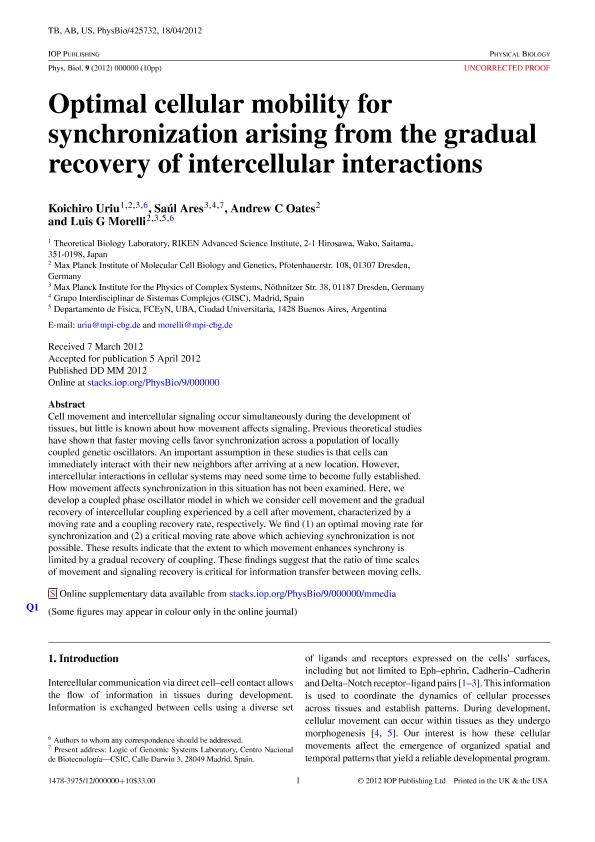Mostrar el registro sencillo del ítem
dc.contributor.author
Uriu, Koichiro

dc.contributor.author
Ares, Saúl
dc.contributor.author
Oates, Andrew C.

dc.contributor.author
Morelli, Luis Guillermo

dc.date.available
2018-08-15T16:46:17Z
dc.date.issued
2012-04
dc.identifier.citation
Uriu, Koichiro; Ares, Saúl; Oates, Andrew C.; Morelli, Luis Guillermo; Optimal cellular mobility for synchronization arising from the gradual recovery of intercellular interactions; IOP Publishing; Physical Biology; 9; 3; 4-2012; 1-11
dc.identifier.issn
1478-3967
dc.identifier.uri
http://hdl.handle.net/11336/55630
dc.description.abstract
Cell movement and intercellular signaling occur simultaneously during the development of tissues, but little is known about how movement affects signaling. Previous theoretical studies have shown that faster moving cells favor synchronization across a population of locally coupled genetic oscillators. An important assumption in these studies is that cells can immediately interact with their new neighbors after arriving at a new location. However, intercellular interactions in cellular systems may need some time to become fully established. How movement affects synchronization in this situation has not been examined. Here, we develop a coupled phase oscillator model in which we consider cell movement and the gradual recovery of intercellular coupling experienced by a cell after movement, characterized by a moving rate and a coupling recovery rate, respectively. We find (1) an optimal moving rate for synchronization and (2) a critical moving rate above which achieving synchronization is not possible. These results indicate that the extent to which movement enhances synchrony is limited by a gradual recovery of coupling. These findings suggest that the ratio of time scales of movement and signaling recovery is critical for information transfer between moving cells. © 2012 IOP Publishing Ltd.
dc.format
application/pdf
dc.language.iso
eng
dc.publisher
IOP Publishing

dc.rights
info:eu-repo/semantics/openAccess
dc.rights.uri
https://creativecommons.org/licenses/by-nc-sa/2.5/ar/
dc.subject
Cellular Mobility,
dc.subject
Intercellular Interaction
dc.subject
Recovery of Signaling
dc.subject
Synchronization
dc.subject
Coupled Mobile Oscillators
dc.subject.classification
Astronomía

dc.subject.classification
Ciencias Físicas

dc.subject.classification
CIENCIAS NATURALES Y EXACTAS

dc.title
Optimal cellular mobility for synchronization arising from the gradual recovery of intercellular interactions
dc.type
info:eu-repo/semantics/article
dc.type
info:ar-repo/semantics/artículo
dc.type
info:eu-repo/semantics/publishedVersion
dc.date.updated
2018-08-10T17:45:01Z
dc.journal.volume
9
dc.journal.number
3
dc.journal.pagination
1-11
dc.journal.pais
Reino Unido

dc.journal.ciudad
Londres
dc.description.fil
Fil: Uriu, Koichiro. Max Planck Institute For The Physics Of Complex Systems; Alemania. Max Planck Institute Of Molecular Cell Biology And Genetics; Alemania
dc.description.fil
Fil: Ares, Saúl. Max Planck Institute For The Physics Of Complex Systems; Alemania
dc.description.fil
Fil: Oates, Andrew C.. Max Planck Institute Of Molecular Cell Biology And Genetics; Alemania
dc.description.fil
Fil: Morelli, Luis Guillermo. Universidad de Buenos Aires; Argentina. Consejo Nacional de Investigaciones Científicas y Técnicas. Oficina de Coordinación Administrativa Ciudad Universitaria. Instituto de Física de Buenos Aires. Universidad de Buenos Aires. Facultad de Ciencias Exactas y Naturales. Instituto de Física de Buenos Aires; Argentina
dc.journal.title
Physical Biology

dc.relation.alternativeid
info:eu-repo/semantics/altIdentifier/url/http://iopscience.iop.org/1478-3975/9/3/036006
dc.relation.alternativeid
info:eu-repo/semantics/altIdentifier/doi/http://dx.doi.org/10.1088/1478-3975/9/3/036006
Archivos asociados
